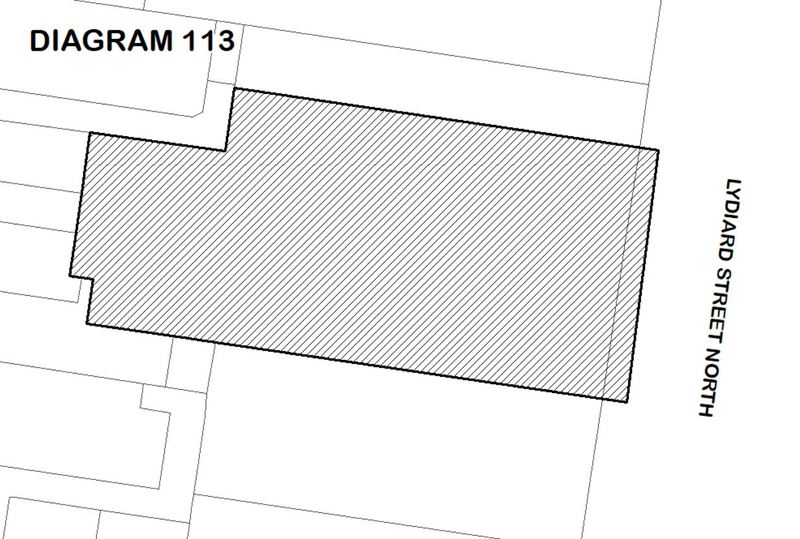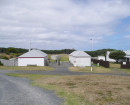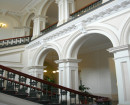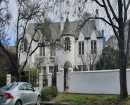GEORGE HOTEL
25 LYDIARD STREET NORTH BALLARAT CENTRAL, BALLARAT CITY
-
Add to tour
You must log in to do that.
-
Share
-
Shortlist place
You must log in to do that.
- Download report





Statement of Significance
What is significant?
The George Hotel, Ballarat is a three-storey brick building with three-storey cast iron verandah and balustraded parapet, built to the designs of Ballarat architects E & B Smith in 1902 with alterations in 1926 and 1938.How is it significant?
The George Hotel, Ballarat is of historical and architectural significance to the State of Victoria. It satisfies the following criterion for inclusion in the Victorian Heritage Register:Why is it significant?
The George Hotel, Ballarat is historically significant for its association with Ballarat’s early mining history. It is also important for its association with its predecessor on the same site, the George Inn, which played a role in the events that culminated in the Eureka Rebellion being the rendezvous point for the civil and military authorities. [Criterion A]-
-
GEORGE HOTEL - History
The first hotel on this site, the George Inn, was built in 1853, and was among the earliest hotels in Ballarat. It was an imposing two storey building located in a key position on Camp Hill, and was a landmark of early Ballarat. It was patronised by the fashionable members of the mining community and was witness to many of the events that shaped early Ballarat, particularly the Eureka uprising of 1854, when it was the rendezvous point for the civil and military authorities. In 1902 it was replaced by the present building, designed by the Ballarat architects E & B Smith and built by J McGregor. The tender price was £8397, and the total cost including furnishings was £17,000. Although built after the boom period, its flamboyant design is akin to the styles of the late nineteenth century. It had seventy five rooms of which thirty were bedrooms. There were four bars, behind which were four sitting rooms, a reading room, complete with grand piano, which opened into the dining room by means of wide folding doors, a commercial room, a billiard room with two tables, and a grand stair hall with an elaborate timber reception desk and a fine walnut staircase. An unusual feature was the carriage way to the right hand side of the building, now closed off, which separated a suite of offices, the George Chambers, on one side from the bars and lounge rooms on the other. The stables at the rear were designed to accommodate both horses and motor vehicles. There were alterations in 1926 by Clegg & Morrow, mainly involving kitchen and bathroom facilities. Alterations in 1938 by L H Vernon involved the upgrade of bar facilities and their redecoration in the Art Deco style, the blocking off of the carriageway, and alterations to the facade. The interior, particularly the stair hall, was damaged by fire in 1988, but has since been restored.
The draft statement of significance and the above history were produced as part of an Online Data Upgrade Project 2003. Sources were as follows:
Andrew C Ward & Associates, ‘The George Hotel, Ballarat. Conservation and Restoration Guide’, 1989.GEORGE HOTEL - Permit Exemptions
General Exemptions:General exemptions apply to all places and objects included in the Victorian Heritage Register (VHR). General exemptions have been designed to allow everyday activities, maintenance and changes to your property, which don’t harm its cultural heritage significance, to proceed without the need to obtain approvals under the Heritage Act 2017.Places of worship: In some circumstances, you can alter a place of worship to accommodate religious practices without a permit, but you must notify the Executive Director of Heritage Victoria before you start the works or activities at least 20 business days before the works or activities are to commence.Subdivision/consolidation: Permit exemptions exist for some subdivisions and consolidations. If the subdivision or consolidation is in accordance with a planning permit granted under Part 4 of the Planning and Environment Act 1987 and the application for the planning permit was referred to the Executive Director of Heritage Victoria as a determining referral authority, a permit is not required.Specific exemptions may also apply to your registered place or object. If applicable, these are listed below. Specific exemptions are tailored to the conservation and management needs of an individual registered place or object and set out works and activities that are exempt from the requirements of a permit. Specific exemptions prevail if they conflict with general exemptions. Find out more about heritage permit exemptions here.Specific Exemptions:The following permit exemptions are not considered to cause harm to the cultural heritage significance of the George Hotel.
General
• Minor repairs and maintenance which replaces like with like. Repairs and maintenance must maximise protection and retention of fabric and include the conservation of existing details or elements. Any repairs and maintenance must not exacerbate the decay of fabric due to chemical incompatibility of new materials, obscure fabric or limit access to such fabric for future maintenance.
• Maintenance, repair and replacement of existing external services such as plumbing, electrical cabling, surveillance systems, pipes or fire services which does not involve changes in location or scale.
• Repair to, or removal of items such as antennae; aerials; and air conditioners and associated pipe work, ducting and wiring.
• Works or activities, including emergency stabilisation, necessary to secure safety in an emergency where a structure or part of a structure has been irreparably damaged or destabilised and poses a safety risk to its users or the public. The Executive Director, Heritage Victoria, must be notified within seven days of the commencement of these works or activities.
• Painting of previously painted external and internal surfaces in the same colour, finish and product type provided that preparation or painting does not remove all evidence of earlier paint finishes or schemes. This exemption does not apply to areas where there are specialist paint techniques such as graining, marbling, stencilling, hand-painting. murals or signwriting, or to wallpapered surfaces, or to unpainted, oiled or varnished surfaces.
• Cleaning including the removal of surface deposits by the use of low-pressure water (to maximum of 300 psi at the surface being cleaned) and neutral detergents and mild brushing and scrubbing with plastic (not wire) brushes.
Permit exemptions for interiors
• Works to maintain or upgrade existing bathrooms, kitchens, and laundries, including installing new appliances, re-tiling and the like.
• Removal or replacement of window furnishings.
• Removal or replacement of carpets and/or flexible floor coverings. Replacement materials should also be carpet or flexible floor covering such as linoleum or vinyl.
• Installation, removal or replacement of existing electrical wiring. If wiring is currently exposed, it should remain exposed. If it is fully concealed it should remain fully concealed.
• Repair and maintenance of existing lifts and escalators including mechanisms and associated elements.
• Removal or replacement of existing hooks, brackets and the like for hanging wall mounted artworks.
• Maintenance, repair and replacement of light fixtures, tracks and the like in existing locations.
• Removal or replacement of smoke and fire detectors, alarms and the like, of the same size and in existing locations.
• Repair, removal or replacement of existing ducted, hydronic or concealed radiant type heating provided that the central plant is concealed, and that the work is done in a manner which does not alter building fabric.
• Installation of plant within the roof space, providing that it does not impact on the external appearance of the building or involve structural changes.
• Installation, removal or replacement of bulk insulation in the roof space.
Outdoor areas
• Repair and maintenance of existing paving and footpaths where fabric, design, scale and form is repaired or replaced like for like.
35 Lydiard Street North (adjacent building to north)
• All works within the internal envelope of the building other than structural changes to the southern party wall with the George Hotel.
GEORGE HOTEL - Permit Exemption Policy
Notes
• All works should ideally be informed by a Conservation Management Plan prepared for the place. The Executive Director is not bound by any Conservation Management Plan, and permits still must be obtained for works suggested in any Conservation Management Plan.
• Nothing in this determination prevents the Heritage Council from amending or rescinding all or any of the permit exemptions.
• Nothing in this determination exempts owners or their agents from the responsibility to seek relevant planning or building permits where applicable.
General Conditions
• All exempted alterations are to be planned and carried out in a manner which prevents damage to the fabric of the registered place.
• Should it become apparent during further inspection or the carrying out of works that original or previously hidden or inaccessible details of the place are revealed which relate to the significance of the place, then the exemption covering such works must cease and Heritage Victoria must be notified as soon as possible.
-
-
-
-
-
FORMER POLICE STATION, BALLARAT
 Victorian Heritage Register H1544
Victorian Heritage Register H1544 -
BALLARAT TRADES HALL
 Victorian Heritage Register H0657
Victorian Heritage Register H0657 -
PRIMARY SCHOOL NO.33
 Victorian Heritage Register H1714
Victorian Heritage Register H1714
-
"1890"
 Yarra City
Yarra City -
"AMF Officers" Shed
 Moorabool Shire
Moorabool Shire -
"AQUA PROFONDA" SIGN, FITZROY POOL
 Victorian Heritage Register H1687
Victorian Heritage Register H1687
-
'Mororo' 13 Oxford Street, Malvern
 Stonnington City
Stonnington City -
1 Arnold Street
 Yarra City
Yarra City -
1 Austin Street
 Yarra City
Yarra City
-
-















